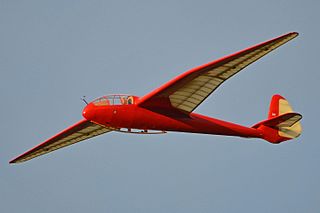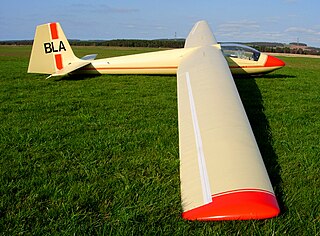Related Research Articles
The Slingsby Type 26 Kite 2 was a post World War II development of the Slingsby Kite, a single seat medium performance sailplane. It sold in small numbers.

The Slingsby T.43 Skylark 3 was a single seat Open Class sailplane developed from the Skylark 2 with an extended wingspan. It won the 1960 World Gliding Championships.

The Slingsby T.13 Petrel was a British single-seat competition glider built by Slingsby Sailplanes just before World War II.

The Slingsby T.50 Skylark 4 was a British single seat competition glider built by Slingsby Sailplanes in the early 1960s. It sold in numbers and had success at national, though not world level competition.
The Buxton Hjordis was a single-seat sailplane built by Slingsby Sailplanes Ltd. in the UK to a design by G.M Buxton. Only one was constructed and was flown by Philip Wills at competitions in Europe between 1935-7.
The Sayers S.C.W. was a single seat monoplane glider, designed specifically for the first British gliding competition held at Itford Hill in 1922, an endurance event. Unresolved control problems stopped it from making any competitive flights, but it flew successfully later in the year. It was destroyed on the ground by a storm in December 1922.

The Abbott-Baynes Scud 1 was a parasol-winged single seat glider intended to introduce pilots to soaring flight. It was built in the United Kingdom and first flew in 1931.

The Abbott-Baynes Scud 2 was a 1930s high-performance sailplane, built in the UK. It was a development of the intermediate-level Scud 1 with a new, high aspect ratio wing.
The Dart Cambridge was a single-seat competition sailplane built in the United Kingdom in the 1930s. A development of the Grunau Baby, only two were built, flying with gliding clubs.
The Ginn-Lesniak Kestrel is a one-off homebuilt two seat sailplane, designed in the United Kingdom in the 1950s and flown in 1969.
The Hick Merlin was a high performance small sailplane built in the United Kingdom in the mid-1930s. It was a wooden, single seat, parasol wing aircraft. Only one was built.
The Latimer-Needham Albatross was the first British-designed and constructed sailplane, flying in 1930. Only one example of this single-seat, wooden aircraft was built.
The Penrose Pegasus was a 1930s high-wing, single-seat, wooden glider from the UK. Designed, built and flown by Harald Penrose until the start of World War II, only one was built at the time though a reproduction was constructed in the 1990s.

The Scott Viking 1 was a single seat, high-performance glider designed and built in the UK just before the Second World War. Only four were constructed, one setting records in Argentina and another remaining active into the 1980s.
The Stedman TS-1 City of Leeds was a parasol wing wooden sailplane, seating two in tandem open cockpits. Only one was built, by its designer in 1934; it remained active until the outbreak of World War II.
The DTGL Sant' Ambrogio was an Italian single seat glider, designed and built by a 19-year-old model aircraft enthusiast, that competed in the 1938 national championships. Four more were constructed from his plans.
The Teichfuss Sparviero was an Italian single seat aerobatic glider, designed by Luigi Teichfuss and flown in 1938.
The Teichfuss Balilla was an Italian single seat primary glider, designed by Luigi Teichfuss and flown in 1939.
The RRG Professor was a very early soaring glider and the first to use a variometer for finding thermals. It was designed by Alexander Lippisch in Germany, first flying in 1928. The Professor was widely built by both flying clubs and factories.
The Schneider ES49 is a two-seat glider trainer, designed, first flown in late August 1951 and commercially produced in Germany but later built from plans by gliding clubs in Australia. A major redesign there led to the ES49B Kangaroo.
References
- 1 2 3 4 5 Ellison, Norman (1971). British Gliders and Sailplanes. London: A & C Black Ltd. pp. 104, 246. ISBN 978-0-7136-1189-2.
- ↑ Robertson, Bruce (1971). British Military Aircraft Serials 1878-1987. Leicester: Midland Counties Publications. p. 202. ISBN 0-904597-61-X.
- ↑ "Transfer to RAFGSA" . Retrieved 31 July 2011.